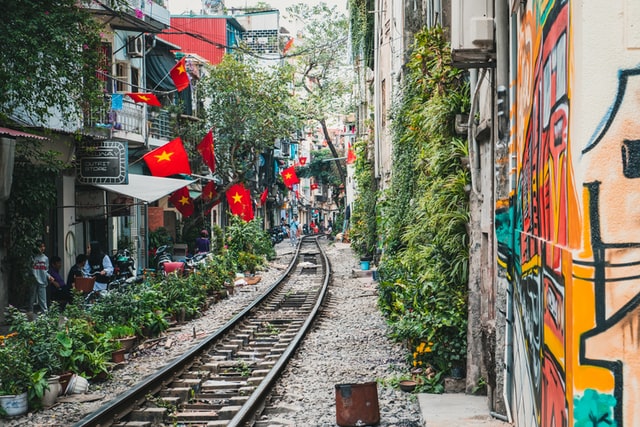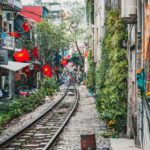Seeing the Human Side of Hanoi’s Street Vendors

Looking over the balcony at my hostel in the Old Quarter of Hanoi, Vietnam, they were one of the first things to catch my eye.
First, I saw the nón lá, the conical hat. Then, the two baskets filled with colourful fruit held together by a wooden stick, all draped over one shoulder. I saw their shuffling feet below them, bravely side-by-side with endless motorcycles, taxis, cars, and cyclos.
They are unforgettable. They are quintessential. Google “Hanoi” and most of the photos feature these female street vendors. A snapshot of them makes a perfect Instagram to say to all of your friends, “Look! I’m in a exotic location!”
From above, they are charming. But, on the streets, they are in your face.
Following me as I walked through busy intersections, shoving fruit and donuts in my hands before I could say no, and shouting, “You buy some!” from across the road, I was slightly irritated.
In fact, one of the most common things I heard among other backpackers traveling through Vietnam is the sense that “this country is amazing, but people won’t leave you alone.” I concurred. I wanted to roam the old quarter free from being haggled. Actually, what I really wanted was to roam without fear of being killed by a motorcycle, but I had already put that dream to rest.
From above, they are charming. But, on the streets, they are in your face.
But my perspective changed on my last day in Hanoi with a visit to the Vietnamese Women’s Museum.
The museum, which details the role that women play and have played throughout history in Vietnam in the realms of family, work life, and fashion, features an exhibition titled “Street Vendors.”
Across from the Women in Family permanent exhibit, I was drawn to the colorful photos on the wall. They were powerful photos of the iconic female street vendors. I sat on a bench facing a TV, and for the next 20 minutes, I was entranced by a documentary of interviews with 33 women who shared their experiences.
Instead of seeing them as annoyances, I saw these women as individuals. Women with stories, histories, likes, dislikes, annoyances, joys, and senses of humor.
For the first time in my visit to Hanoi, I was taken out of my narrow and irritated point of view. As I watched, I began to see the city from their perspective. As I, a tourist, gallivant around trying to soak up the character of the city, they are working from 2:00am until sometimes 7:00pm for a take-home pay of around 25,000 Dong (around $1.12 USD). Most of them rural peasants who migrate for weeks at a time to the city, they sleep in crowded shared housing for around $0.35 USD a night. According to the exhibition, “They think of the city as a place to earn a living, not a place they belong to.”
Instead of seeing them as annoyances, I saw these women as individuals. Women with stories, histories, likes, dislikes, annoyances, joys, and senses of humor. Single mothers, wives, sisters, widows–they were no longer “the women who threw fruit at you in the Old Quarter.” They were Nguyen, Ngo, Tran, and Doi.
Some of the women lamented their separation from their children, whom they had left with a family member hundreds of kilometers away. Others shared their business tactics. One woman spoke of the fear she suffers when the police chase her away on their motorcycles.
Seeing the Human Side of Hanoi’s Street Vendors
The most striking part of the interviews was the overwhelming consensus from the women that none of them do this work because they enjoy it. Rather, it is a survival technique when all other options have been exhausted.
What I didn’t realize was that vendors had been banned from most streets in the city in 2008 in an attempt to “modernize.” In fact, these women, each with her own world of troubles, have become the focus point of a political agenda.
I realized their presence is point of contention. No longer individuals with wants or needs, they are caught in a political battlefield between current development policies and nostalgia for historic Hanoi. Meanwhile, they are struggling to provide school tuition for their children and food for their families.
Now I recognize them for their strength and determination to do whatever is necessary to survive.
Walking home from the museum, I had all of their stories running through my head. I saw a woman with a conical hat and blue button down shirt calling at me to buy dragon fruit. I tried to put this in perspective.
Knowing their plight doesn’t mean that I pity them. It doesn’t mean that I buy something from every one of them. Instead, now I recognize them for their strength and determination to do whatever is necessary to survive. It also means that instead of feeling irritated, I can smile and calmly say, “No thank you,” if I don’t want something.
Their beauty and poise still evoke the perfect photograph. But now, when I see a picture of them, I try imagine what it is like to be in their world.
Seeing the Human Side of Hanoi’s Street Vendors
Related Reading
Meeting My Best Friend in Hanoi, Vietnam
Have you traveled to Hanoi? How was your trip? Email us at editor@pinkpangea.com for information about sharing your experience and advice with the Pink Pangea community. We can’t wait to hear from you.
Seeing the Human Side of Hanoi’s Street Vendors photo credit by Unsplash.









Great article! Loved this part: Knowing their plight doesn’t mean that I pity them. It doesn’t mean that I buy something from every one of them. Instead, now I recognize them for their strength and determination to do whatever is necessary to survive. It also means that instead of feeling irritated, I can smile and calmly say, “No thank you,” if I don’t want something.
Thank you so much Kimberly!